Eating fresh lettuce straight from the garden can’t be beaten – it’s the key component of salad. The leaves are packed full of vitamins, especially vitamin A and C. The salad leaves have a long harvesting period and the thinnings can be eaten all year round. Remember to consider weather protection, in the form of cloches, when making early or late sowings.
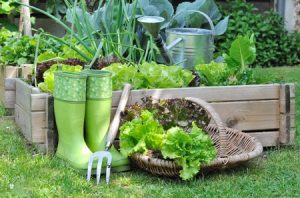
There are so many varieties available but a few are certainly recommended below. It’s also possible to have winter lettuce which means it is a salad available throughout the year. We recommend varieties like Brighton, Valian, Winter Density and Navara which represent the great number of types for the grower.
Sowing
Seed for full grown plants are sown from February to the end of August in the United Kingdom. Until May, it’s best to sow in the greenhouse with some warmth. Only until the last frosts have gone is it worth sowing any outside. When growing outside, prepare the ground where these crops are to be grown and make sure all soil is watered.
Sow seed at a depth of 1.5cm, with a spacing of 25cm apart for rows. Seedlings will start to be visible in 7 to 14 days.
Sowings made in the summer will have developed by spring the next year.
For baby leaf salads, the seed is best sown in pots or trays where accessability is key. Seeds should be spaced about an inch or 2 cm apart to avoid overcrowding. These are then covered with fine vermiculite, perlite or sieved compost but light is essential for germination, so only a slight layer is needed. Perlite and vermiculite are ideal as they keep the tiny leaves clean on germination.
When sowing inside, it is best to keep the seeds as cool as possible because germination is delayed, even reduced in heat until the weather cools. Seeds sown outside are best germinated in a reasonably sunny to semi-shaded spot. General fertiliser should be added including chicken and sheep manures pellets which should be raked in a week beforehand. Any early sowings are covered with cloches to protect from late frosts and cold snaps.
To have a regular crop available to harvest, you can carry out seed sowing every two or three weeks.
Growing On
Seedlings need to produce a few leaves before transplanting or thinning out to their final spacing which is about 10in. (20-25cm). These thinnings can be eaten but they can also be transplanted to different parts of the vegetable patch.
The rows need to be weeded regularly especially to reduce attack by slugs and snails lurking in the undergrowth. Watering is essential during spells of hot water and best done early or late in the day to avoid scorching in periods of sunny weather.
One alternative method for quick, reliable results is to buy a punnet of salad leaves from a supermarket and simply grown on !
Harvesting
Once the heads have grown to a certain size, they are best harvested otherwise they can bolt by producing flower heads. Any loose-leaf types are harvested whole or a few leaves can be picked from each plant as the head develops. Baby leaves are harvested by cutting the leaf with sharp scissors. The growing point must be carefully left alone otherwise the plant stops growing. It is possible to obtain two or three harvests.
Any plants growing in pots and trays should receive the occasional liquid feed such as that used for tomato fertiliser. This encourages them to produce further leaves once they are cut.
Lettuce Cultivars
This page contains links to our affiliate marketing partner. Please read our affiliate disclosure.
All The Year Round – one of the best medium sized ‘butterhead’ types producing very large plants when given space. Compact and slow to bolt having a long season compared to other types. If you sow seeds from March to August, you can harvest them from October to the following year’s April to May. Buy seeds of All The Year Round from Johnsons Seeds.
Bijou – typical red lettuce, strong growth and colourful.
Brighton – a very hardy and a great variety for planting out in September. It is reliably tasty and produces delicious hearts throughout the winter months. It is a good winter lettuce variety.
Catalogna – a classic Italian oak-leaved variety available for whole head and baby leaf salads.
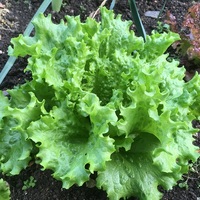 Emocion – A premium dark green coloured Batavian lettuce which is ideal for outdoor growing. This variety is compact and slow bolting and highly suitable to growing during Spring and Summer sowings.
Emocion – A premium dark green coloured Batavian lettuce which is ideal for outdoor growing. This variety is compact and slow bolting and highly suitable to growing during Spring and Summer sowings.
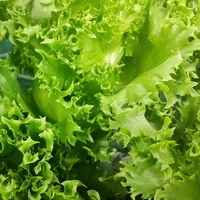 Frillice Best described as a Curly Iceberg, Lettuce Frillice is actually a Iceberg Lettuce / Endive cross. This variety is found in the supermarket prepacks, and although has a mild taste, it can also be suitable for soups and shredding into mixes.
Frillice Best described as a Curly Iceberg, Lettuce Frillice is actually a Iceberg Lettuce / Endive cross. This variety is found in the supermarket prepacks, and although has a mild taste, it can also be suitable for soups and shredding into mixes.
Frisee De Beauregard – a beautiful, rather flamboyant lettuce and almost an ornamental.
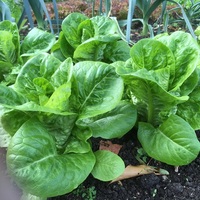 Little Gem – a cross between a Cos and Romaine type which is ideal for braising as well as the salad bowl. Little Gem is very popular with amateur growers, and also a best seller in the supermarkets. It is a quick maturing, compact small cos type with tight hearts with a very sweet flavour.
Little Gem – a cross between a Cos and Romaine type which is ideal for braising as well as the salad bowl. Little Gem is very popular with amateur growers, and also a best seller in the supermarkets. It is a quick maturing, compact small cos type with tight hearts with a very sweet flavour.
Buy seeds of Little Gem now from Premier Seeds Direct.
Lobjoits Green Cos – one of the larger Cos types with large, sweet heads. Popular with amateur growers, it is still considered to be one of the best flavoured Cos varieties. Harvest until the end of June.
 Lollo Rosso – An open leafed, non-hearting type with red tinged leaves and waved, serrated edges. Another popular lettuce with amateur growers as it is easy to grow.
Lollo Rosso – An open leafed, non-hearting type with red tinged leaves and waved, serrated edges. Another popular lettuce with amateur growers as it is easy to grow.
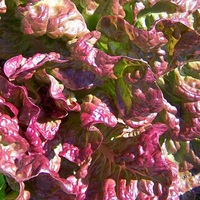 Marvel Of Four Seasons – a beautiful red-green type of lettuce with attractive curled leaves. Produces good solid heads. Best results are obtained from spring and autumn sowing, but as the name suggests this variety will yield some excellent heads all year.
Marvel Of Four Seasons – a beautiful red-green type of lettuce with attractive curled leaves. Produces good solid heads. Best results are obtained from spring and autumn sowing, but as the name suggests this variety will yield some excellent heads all year.
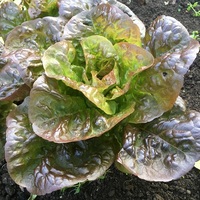 Moon Red -. One of our favourites, Lettuce Moon Red is a little gem type lettuce with deep red outer leaves and a green heart. Growth wise it is slightly larger than Little Gem, but still compact with an upright habit.
Moon Red -. One of our favourites, Lettuce Moon Red is a little gem type lettuce with deep red outer leaves and a green heart. Growth wise it is slightly larger than Little Gem, but still compact with an upright habit.
Navarra – a small red butterhead lettuce. It is a shiny dark red oakleaf variety producing medium sized heads on compact lettuce plants. The leaves inside the plants are a pulsing green. One variety with good disease resistance.
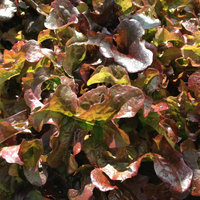 Red Salad Bowl- Produces a large, fast growing rosette with long, brownish red deep cut leaves. Heat tolerant and great for growing as a cut and come again lettuce.
Red Salad Bowl- Produces a large, fast growing rosette with long, brownish red deep cut leaves. Heat tolerant and great for growing as a cut and come again lettuce.
Saladin The variety is a regular iceberg lettuce variety, producing fairly dense, large dark green heads. The lettuce has very good holding ability. Comes highly recommended.
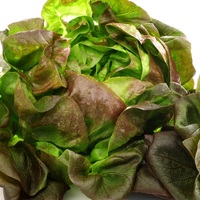 Sebastiano A premium large red butterhead variety bred for growing outdoors. The leaves are slightly savoyed with a nice shiny gloss to them. Sebastiano is slow bolting and highly suitable for summer harvesting.
Sebastiano A premium large red butterhead variety bred for growing outdoors. The leaves are slightly savoyed with a nice shiny gloss to them. Sebastiano is slow bolting and highly suitable for summer harvesting.
Tom Thumb – a small hearted variety and one of the fastest to reach maturity.
Valdor – a butterhead type ideal for September planting.
Valian – one of the popular winter lettuce types which is similar to ‘Little Gem’. Ideal for growing in an unheated greenhouse providing sweet and crunchy heads from autumn to early spring. It has good disease resistance.
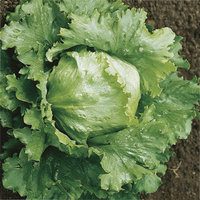 Webbs Wonderful – the classic ‘iceberg’ variety producing extremely large hearts. Generally, a large headed variety with frilly edged leaves. A popular iceberg variety amongst amateur gardeners as it is slow to bolt even in hot conditions.
Webbs Wonderful – the classic ‘iceberg’ variety producing extremely large hearts. Generally, a large headed variety with frilly edged leaves. A popular iceberg variety amongst amateur gardeners as it is slow to bolt even in hot conditions.
Winter Density (cos) – A typical winter lettuce variety which is a cos type and so larger than ‘Little Gem’. It has a pleasing flavour. One of the most popular varieties available.
Lettuce Seed Mixes
Lettuce seed mixes are available from a variety of seed suppliers. We would recommend you try the Gourmet Looseleaf cutting mix from Premier Seeds Direct.
You can also try a mixed leaf variety called Mesclun which also comes from Premier Seeds Direct.
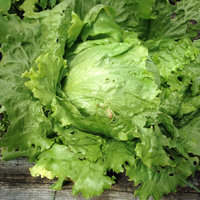
Leave a Reply